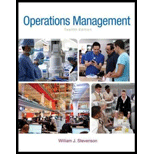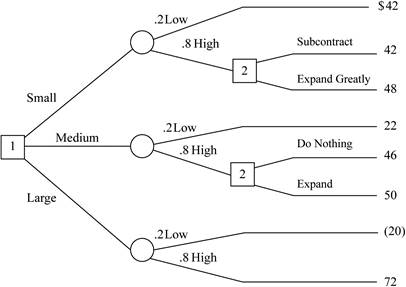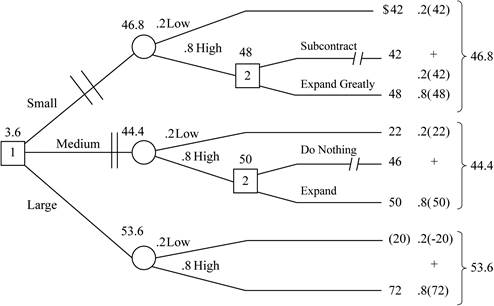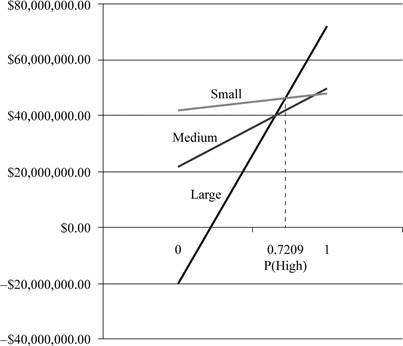
Concept explainers
a)
To draw: A decision tree for the given problem.
Introduction:
Decision tree is one of the methods used in decision-making process. It would graphically represent the available alternatives and states of nature. It would also mention the payoffs and probabilities of the alternatives. It helps to choose the best alternative that would give the best result among the alternatives.
a)
Explanation of Solution
Given information:
Three decision alternatives:
- 1st construct small stamping plant
- 2nd construct medium stamping plant
- 3rd construct stamping plant
Each decision has demand:
- Low demand which have 20% probability
- Low demand which have 80% probability
- If firm build small facility and demand turn out to be low than
NPV is $42,000,000 - If firm build small facility and demand turn out to be high than either subcontract or expand greatly, if sub contract than NPV is $42,000,000 and if expand greatly than $48,000,000.
- If firm build medium facility and demand turn out to be low than NPV is $22,000,000.
- If firm build medium facility and demand turn out to be high than either it do nothing or expand, if sub contract than NPV is $46,000,000 and if expand greatly than $50,000,000.
- If firm build large facility and demand turn out to be low than NPV is -$20,000,000.
- If firm build large facility and demand turn out to be high than NPV is $72,000,000.
As per given information, construct the decision tree:

Now, calculate the value of payoff and monetary value in decision tree:

Analysis the decision from right to left:
- In the decision tree, there are two decisions making; first decision is between small, medium and large and second decision is between high demand of small and medium build facilities.
- If small facilities build with high demand then select expand greatly because the payoff of expand greatly is higher than subcontract. The payoff of expand greatly is $48,000,000 and place double slash (reject) on subcontract.
- If large facility build with high demand then select expand, because the payoff of expand greatly is higher than do nothing. The payoff of expand is $50,000,000 place double slash (reject) on do nothing.
Calculate the product of the chance probabilities and their respective payoffs for the remaining branches:
- If small facility build:
- If medium facility IS build:
- If large facility is build:
Calculation of the expected value in each alternative:
- If small facility build
- If medium facility build
- If large facility build
Here, it is obtained that large facility build have higher expected value, hence it should be selected. And small and medium facilities have to be rejected.
b)
To determine: Maximin alternatives
Introduction:
Maximin is the decision making method which is used to make decision under uncertainty. This method will find an alternative that maximizes the minimum outcome of every alternative or we can say that calculating the minimum outcome within the each alternative.
b)
Answer to Problem 9P
Explanation of Solution
Determine the worst possible alternatives from the given demand:
As definition stated above, Maximim is the selection from the best of the worst possible payoff for each alternatives.
| Alternative | Next Year’s Demand | Worst Payoff | Decision | |
| Low | High | |||
| Small | $42,000,000.00 | $48,000,000.00 | $42,000,000.00 | Best of the Worst |
| Medium | $22,000,000.00 | $50,000,000.00 | $22,000,000.00 | |
| Large | -$20,000,000.00 | $72,000,000.00 | -$20,000,000.00 | |
Hence, the best decision according to Maximin decision is to select a small medium facility.
c)
To determine: Expected value of perfect information (EVPI) and interpret it.
Expected value of perfect information: It is the rate that a person is willing to pay to gain access to perfect information. A common area which uses expected value of perfect information is the healthcare economy. This value tries to evaluate the expected cost of the uncertainty, which can be interpreted as the expected value of perfect information
The expected value of perfect information can be calculated by using below given formula:
c)
Answer to Problem 9P
Explanation of Solution
Calculate the expected value with perfection information or Expected payoff under certainty:
Calculate the expected value with perfect information:
Therefore, EVPI is $12,400,000.
d)
To determine: The sensitive analysis on P (high).
Introduction
Decision table is formats or visual representations were data is expressed arranged, determined and calculated to make a effective decision making. A decision table is a tabular representation that is used to analyze decision alternatives and states of nature.
d)
Explanation of Solution
Explanation
Here we draw each alternative to P (high), low demand should be on the left hand side and high demand value on the right hand side:
| Next Year’s Demand | ||
| Alternative | Low | High |
| Small | $42,000,000.00 | $48,000,000.00 |
| Medium | $22,000,000.00 | $50,000,000.00 |
| Large | -$20,000,000.00 | $72,000,000.00 |
Graph plot:

From the above graph, we can determine the value of P (high) where each alternative are optimal.
From the graph, we can obtain that small build facility is best option, because of higher expected value. For low value of P(high) while for higher and intermediate value of P(high) large is the best option.
Calculate the range needed to determine upper part of line intersects:
For each line, b is the slope of the line and x = P(High). The slope of each line
Determination of equation:
Small build facility = 42+6P (because high demand $48 million which is subtracted with low demand value $42 million)
Large build facility =-20+92P (because high demand $72million which is subtracted with low demand value -$20million)
Determination of intersection between small and large
Hence, the intersection between small and large is 0.7209.
Therefore, optimal range can be derived as:
Small: P (High) = 0 to < .7209
Large: P (High) > .7209 to 1.00
Want to see more full solutions like this?
Chapter 5 Solutions
Operations Management (McGraw-Hill Series in Operations and Decision Sciences)
- Sarah Anderson, the Marketing Manager at Exeter Township's Cultural Center, is conducting research on the attendance history for cultural events in the area over the past ten years. The following data has been collected on the number of attendees who registered for events at the cultural center. Year Number of Attendees 1 700 2 248 3 633 4 458 5 1410 6 1588 7 1629 8 1301 9 1455 10 1989 You have been hired as a consultant to assist in implementing a forecasting system that utilizes various forecasting techniques to predict attendance for Year 11. a) Calculate the Three-Period Simple Moving Average b) Calculate the Three-Period Weighted Moving Average (weights: 50%, 30%, and 20%; use 50% for the most recent period, 30% for the next most recent, and 20% for the oldest) c) Apply Exponential Smoothing with the smoothing constant alpha = 0.2. d) Perform a Simple Linear Regression analysis and provide the adjusted…arrow_forwardRuby-Star Incorporated is considering two different vendors for one of its top-selling products which has an average weekly demand of 70 units and is valued at $90 per unit. Inbound shipments from vendor 1 will average 390 units with an average lead time (including ordering delays and transit time) of 4 weeks. Inbound shipments from vendor 2 will average 490 units with an average lead time of 2 weeksweeks. Ruby-Star operates 52 weeks per year; it carries a 4-week supply of inventory as safety stock and no anticipation inventory. Part 2 a. The average aggregate inventory value of the product if Ruby-Star used vendor 1 exclusively is $enter your response here.arrow_forwardSam's Pet Hotel operates 50 weeks per year, 6 days per week, and uses a continuous review inventory system. It purchases kitty litter for $13.00 per bag. The following information is available about these bags: > Demand 75 bags/week > Order cost = $52.00/order > Annual holding cost = 20 percent of cost > Desired cycle-service level = 80 percent >Lead time = 5 weeks (30 working days) > Standard deviation of weekly demand = 15 bags > Current on-hand inventory is 320 bags, with no open orders or backorders. a. Suppose that the weekly demand forecast of 75 bags is incorrect and actual demand averages only 50 bags per week. How much higher will total costs be, owing to the distorted EOQ caused by this forecast error? The costs will be $higher owing to the error in EOQ. (Enter your response rounded to two decimal places.)arrow_forward
- Yellow Press, Inc., buys paper in 1,500-pound rolls for printing. Annual demand is 2,250 rolls. The cost per roll is $625, and the annual holding cost is 20 percent of the cost. Each order costs $75. a. How many rolls should Yellow Press order at a time? Yellow Press should order rolls at a time. (Enter your response rounded to the nearest whole number.)arrow_forwardPlease help with only the one I circled! I solved the others :)arrow_forwardOsprey Sports stocks everything that a musky fisherman could want in the Great North Woods. A particular musky lure has been very popular with local fishermen as well as those who buy lures on the Internet from Osprey Sports. The cost to place orders with the supplier is $40/order; the demand averages 3 lures per day, with a standard deviation of 1 lure; and the inventory holding cost is $1.00/lure/year. The lead time form the supplier is 10 days, with a standard deviation of 2 days. It is important to maintain a 97 percent cycle-service level to properly balance service with inventory holding costs. Osprey Sports is open 350 days a year to allow the owners the opportunity to fish for muskies during the prime season. The owners want to use a continuous review inventory system for this item. Refer to the standard normal table for z-values. a. What order quantity should be used? lures. (Enter your response rounded to the nearest whole number.)arrow_forward
- In a P system, the lead time for a box of weed-killer is two weeks and the review period is one week. Demand during the protection interval averages 262 boxes, with a standard deviation of demand during the protection interval of 40 boxes. a. What is the cycle-service level when the target inventory is set at 350 boxes? Refer to the standard normal table as needed. The cycle-service level is ☐ %. (Enter your response rounded to two decimal places.)arrow_forwardOakwood Hospital is considering using ABC analysis to classify laboratory SKUs into three categories: those that will be delivered daily from their supplier (Class A items), those that will be controlled using a continuous review system (B items), and those that will be held in a two bin system (C items). The following table shows the annual dollar usage for a sample of eight SKUs. Fill in the blanks for annual dollar usage below. (Enter your responses rounded to the mearest whole number.) Annual SKU Unit Value Demand (units) Dollar Usage 1 $1.50 200 2 $0.02 120,000 $ 3 $1.00 40,000 $ 4 $0.02 1,200 5 $4.50 700 6 $0.20 60,000 7 $0.90 350 8 $0.45 80arrow_forwardA part is produced in lots of 1,000 units. It is assembled from 2 components worth $30 total. The value added in production (for labor and variable overhead) is $30 per unit, bringing total costs per completed unit to $60 The average lead time for the part is 7 weeks and annual demand is 3800 units, based on 50 business weeks per year. Part 2 a. How many units of the part are held, on average, in cycle inventory? enter your response here unitsarrow_forward
- assume the initial inventory has no holding cost in the first period and back orders are not permitted. Allocating production capacity to meet demand at a minimum cost using the transportation method. What is the total cost? ENTER your response is a whole number (answer is not $17,000. That was INCORRECT)arrow_forwardRegular Period Time Overtime Supply Available puewag Subcontract Forecast 40 15 15 40 2 35 40 28 15 15 20 15 22 65 60 Initial inventory Regular-time cost per unit Overtime cost per unit Subcontract cost per unit 20 units $100 $150 $200 Carrying cost per unit per month 84arrow_forwardassume that the initial inventory has no holding cost in the first period, and back orders are not permitted. Allocating production capacity to meet demand at a minimum cost using the transportation method. The total cost is? (enter as whole number)arrow_forward
 Practical Management ScienceOperations ManagementISBN:9781337406659Author:WINSTON, Wayne L.Publisher:Cengage,
Practical Management ScienceOperations ManagementISBN:9781337406659Author:WINSTON, Wayne L.Publisher:Cengage, Purchasing and Supply Chain ManagementOperations ManagementISBN:9781285869681Author:Robert M. Monczka, Robert B. Handfield, Larry C. Giunipero, James L. PattersonPublisher:Cengage LearningMarketingMarketingISBN:9780357033791Author:Pride, William MPublisher:South Western Educational Publishing
Purchasing and Supply Chain ManagementOperations ManagementISBN:9781285869681Author:Robert M. Monczka, Robert B. Handfield, Larry C. Giunipero, James L. PattersonPublisher:Cengage LearningMarketingMarketingISBN:9780357033791Author:Pride, William MPublisher:South Western Educational Publishing Management, Loose-Leaf VersionManagementISBN:9781305969308Author:Richard L. DaftPublisher:South-Western College Pub
Management, Loose-Leaf VersionManagementISBN:9781305969308Author:Richard L. DaftPublisher:South-Western College Pub




